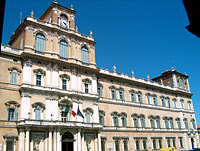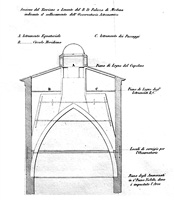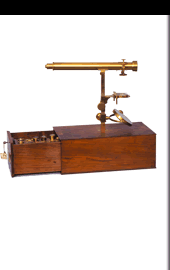Instruments
Transit Instrument
Only one exemplar of this instrument came out of Amici’s workshop, in April 1827. Its story is closely related to that of the foundation of the Observatory of Modena.
Archduke Maximilian, brother of Francis IV, greatly admired Amici, and in the autumn of 1814 conceived the idea of providing the capital of the Este Dukedom with an astronomical observatory. Maximilian considered the young Giuseppe Bianchi (1791-1866) as the best choice for the future astronomer. Bianchi had completed his university degree in Mathematics in 1813 in preparation for this career, and he was then sent to Milan with a subsidy from the Dukedom to finish his training under the Brera astronomers Oriani and Cesaris. He returned to Modena in 1818, where he was awarded the chair, created for him, in Theoretical Astronomy. Modena now only needed the building and equipment for an observatory.
 While an appropriate location was being sought, the new astronomer indicated the following instruments as fundamental: a Transit Instrument for right ascensions, a Meridian Circle with at least three feet of diameter for the declinations, an Equatorial Telescope for the extra-meridian observations and a good Achromatic Telescope. When Amici was consulted about the possibility of their construction he expressed his wish that one of the four instruments be purchased abroad in order to compare constructions. On 21 February, 1818, Bianchi commissioned a Meridian Circle from Reichenbach in Munich, and on 9 June, 1820 Amici delivered a Newtonian Reflecting Telescope, a choice he had expressed as preferred over the Achromatic one.
While an appropriate location was being sought, the new astronomer indicated the following instruments as fundamental: a Transit Instrument for right ascensions, a Meridian Circle with at least three feet of diameter for the declinations, an Equatorial Telescope for the extra-meridian observations and a good Achromatic Telescope. When Amici was consulted about the possibility of their construction he expressed his wish that one of the four instruments be purchased abroad in order to compare constructions. On 21 February, 1818, Bianchi commissioned a Meridian Circle from Reichenbach in Munich, and on 9 June, 1820 Amici delivered a Newtonian Reflecting Telescope, a choice he had expressed as preferred over the Achromatic one.
 The birth of the observatory was delayed for many reasons, most especially due to the difficulty of finding an appropriate building. The Duke at last decided to allow the observatory to open in his own Palace, precisely in the oldest part of the Palace, built in 1634, in the upper part of the tower which looks East. The sovereign’s decision was, however, formalized only on 14 January, 1826, and the work, begun in the spring, lasted more than 16 months.
The birth of the observatory was delayed for many reasons, most especially due to the difficulty of finding an appropriate building. The Duke at last decided to allow the observatory to open in his own Palace, precisely in the oldest part of the Palace, built in 1634, in the upper part of the tower which looks East. The sovereign’s decision was, however, formalized only on 14 January, 1826, and the work, begun in the spring, lasted more than 16 months.
In July 1827, even if the work was not all completed, Bianchi hastened “to fix the transit instrument to its bases, and the Grindel clock nearby [...] moved by the desire to observe the instantaneous flashes” which were to serve in checking the difference in longitude compared to Milan.
 The new observatory began functioning in August 1827. Bianchi was the first director and remained in the position until 1859. Amici had supplied the observatory with a transit instrument with a 5 foot focus and 4 inch aperture telescope, an equatorial telescope with 2-foot diameter hour and declination rings divided, respectively, in 4" in 4" and 15" in 15", divisions made with a machine he himself had invented, and a Newtonian telescope with an 8 foot focus and 6 inch aperture, as well as with a double image micrometer for a Dollond telescope. Later there would be a second Newtonian telescope of larger size, a Gregory catoptric telescope, a microscope with a camera lucida and a dividing machine (cf. Carlo Bonacini, Fondazione dell’Osservatorio (1827), in Nel Primo Centenario della Fondazione dell’Osservatorio 1827-1927 < The First Hundred Years from the Foundation of the Observatory >, publication no. 39 of the Geophysics Observatory at the Royal University of Modena, Modena 1927).
The new observatory began functioning in August 1827. Bianchi was the first director and remained in the position until 1859. Amici had supplied the observatory with a transit instrument with a 5 foot focus and 4 inch aperture telescope, an equatorial telescope with 2-foot diameter hour and declination rings divided, respectively, in 4" in 4" and 15" in 15", divisions made with a machine he himself had invented, and a Newtonian telescope with an 8 foot focus and 6 inch aperture, as well as with a double image micrometer for a Dollond telescope. Later there would be a second Newtonian telescope of larger size, a Gregory catoptric telescope, a microscope with a camera lucida and a dividing machine (cf. Carlo Bonacini, Fondazione dell’Osservatorio (1827), in Nel Primo Centenario della Fondazione dell’Osservatorio 1827-1927 < The First Hundred Years from the Foundation of the Observatory >, publication no. 39 of the Geophysics Observatory at the Royal University of Modena, Modena 1927).
In the Inventory of the Royal Astronomical Observatory of Modena, drawn up on 31 May 1845, Bianchi described the transit instrument:
The transit instrument has the telescope, with an objective lens of [empty space] lines of aperture and with 5 feet of focus, with four astronomical eyepieces for the magnification of [empty space], and it also has a tube and brass brackets for the suspension of the level to the axis of rotation. However the air bubble and glass scale levels which are used for the meridian circle can be adapted to the fulcra of this latter tube since none were made specifically for the transit instrument. It also has supplied with a vertical semicircle with a small vernier at one end of the axis only to index the height of the star being observed. It receives illumination at night from a painted tin lantern which communicates the light along the axis through the pillars of marble using two hollow brass tubes with smooth internal surfaces. The entire preparation of this
instrument was directed and supported by our illustrious Prof. Amici [...]
Amici’s transit instrument has been recently restored and in January 2002 placed in its original place next to Reichenbach’s meridian circle, also restored, in the East Tower of the ex-Ducal Palace of Modena, today home to the Military Academy.
At the centre of the horizontal axis holding the telescope there is the signature and date: “Amici 1826”.
